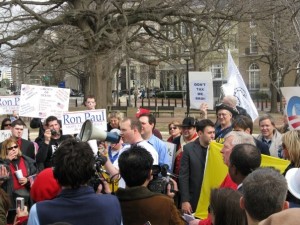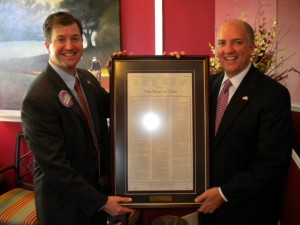Five years ago on St. Patrick’s Day (March 17, 2009), I organized the first Tallahassee Tea Party at the historic Florida Capitol.
It wasn’t my first tea party. I had actually been inspired by my friends Brendan Steinhauser, J.P. Freire, and John O’Hara. They had worked with Michele Malkin to host the first tea party outside the White House, on February 27, 2009 during the CPAC weekend. There were about 300 of us protesting outside the White House, just about 10 days after Rick Santelli went on his famous rant. After attending that rally and seeing about 50 others that took place that same day around the country, I came back to Tallahassee motivated to do something here, to make the tea party local.

Using the power of social media and my own personal network, somehow we managed to get about 225 people to the State Capitol. I don’t know why I chose St. Patrick’s Day. I know that all along my intent was to do something even bigger on April 15 (Tax Day). I had learned that after the first round of tea parties in February, many more were being planned for Tax Day. But I guess I felt we needed a “trial run” somewhere in between and I thought (probably foolishly) that St. Patrick’s Day would offer us a neat theme. Had I chose another day, maybe more than 225 would have showed up (after all, Tallahassee is a drinking town with a football problem). But the 225 of us that did show up were motivated after that day – most of us couldn’t believe that many people had come out.
I gathered all the emails I could that day and signed up people to be “Tea Party Team Leaders.” About 30 or so people took up that responsibility. Over the next four weeks, I asked them all (with many nagging emails and phone calls) to each get about 20-30 people to come. I thought, with those numbers, we would reach about 500-600 people and that the rest would probably hear about it in some other way and we would be able to get 1,000 people to show up in force.

Things were just a whirlwind during those weeks. So many people were calling and emailing me. So many people came out of the woodwork to do something. I even heard from a musician who wanted to play – and bring speakers and a microphone. I was working hard to secure some elected officials to join us. After securing four good ones, I then had other private citizens and other elected officials calling me (seriously, who am I and how did they get my number?) asking me if they could speak at the tea party. I had to turn some of them down, but invited them to come stand with us on the steps of the Capitol. Many did.
To my surprise, on April 15, 2009, more than 2,000 people showed up to take part in a massive tea party at the Florida Capitol – in the middle of legislative session! Here we were – a movement comprised of people from all walks of life – showing up because we thought we could make a difference, or maybe because we finally had it and decided we must make a difference.

While that month or so was grueling, my phone and email lighted up in the days, weeks, and months following April 15. People wanted to know what was next, what we could do, and how they could stay involved. I was overwhelmed and worn out. I did not seek to become the “leader” of any movement, I only wanted to raise awareness and get people involved. Over those next months I kept trying to find someone to “pass off” this new found “leadership” to, but I found that not very many people are good at organizing. Perhaps for me it comes naturally.
Finally, I was able to pass off the leadership of the “Tallahassee Tea Party” to others, but it took nearly two years. But I was really of the belief that the tea party did not need to become its own organization, but rather a movement, influencing other organizations, including both of the major political parties. I’ll repeat a mantra I’ve stated many times before: If it were not for the failures of the Republican Party, there would be no need for the tea party. The tea party’s beginnings was less about fighting Obama than it was about making the Republican Party live up to the limited government, free-market beliefs it espouses.

Much has happened in the tea party movement and in the country as a whole since those first days in 2009. In the rest of this blog that follows, I thought I would reflect on “Five Things the Tea Party Movement Contributed” and “Five Things the Tea Party Movement Still Needs to Learn.” These are only my personal reflections, but I thought they might be helpful.
Five Things the Tea Party Movement Contributed
1. The Awakening: Perhaps the single greatest achievement of the tea party is it took people who were not previously engaged in politics and public policy off the couch and got them engaged. Most of the people showing up at tea party rallies had never been to a political rally in their life. Many continued to stay engaged – at the ballot box, by joining liberty-minded organizations, and keeping themselves and their neighbors informed.
2. Shaking Up Congress: The tea party began in 2009 and it continued to be strong right through the November 2010 election, radically changing the makeup of Congress. It not only helped the Republican Party win a landslide midterm election, but also brought in a new breed of Republicans, committed to the principles the party platform says it believes in. For us locally in Tallahassee, it allowed us to oust 7-term incumbent Allen Boyd and replace him with political novice Steve Southerland, a funeral director by trade. He buried Boyd by double digits and won re-election in 2012.

3. Shaking Up the States: The November 2010 elections also helped Republicans regain control of the majority of the state houses and Governor’s seats. In Florida, tea party favorite Rick Scott, another non-politician at the time, won a tough primary against a conservative establishment candidate, Bill McCollum, and held on to win the Governor’s seat against Democrat Alex Sink. At the same time, Marco Rubio ousted then-Republican Governor Charlie Crist in a battle for a U.S. Senate seat. Without the tea party, Charlie Crist may have never been exposed for the opportunist that he is. Other tea party favorites across the country also won seats in the U.S. Senate, including Rand Paul, Pat Toomey, and Mike Lee, among others. Some had to fight tough primaries against Republican establishment candidates (including incumbents) to win. Those fights represent the first fight the tea party needed to engage: a battle for the soul of the Republican Party.
4. Stalling Obamacare: Few remember that “the public option” was a serious matter on the table at the beginning of the health care debate. The tea party made sure that course was not pursued and it fought every element proposed by Obamacare’s staunchest advocates. The tea party also emboldened elected officials to stop it. This movement was so powerful on the health care issue that it helped a Republican (Scott Brown) to win Ted Kennedy’s Senate seat in Massachusetts in a special election after his death, with the purpose of sending a message to Washington that we the people did not want any further government intrusion into the most intimate elements of our lives: our health care. Later that year, after Obamacare still narrowly passed, most representatives who voted for it, lost their seats and were sent home. Other elected officials resigned so they didn’t have to face the embarrassment of losing an election.
5. It’s the Spending, Stupid: If the “Reagan Revolution” slowed and stalled new taxes being passed by Congress, the “tea party movement” went to the heart of the matter: spending. In fact, as Grover Norquist of Americans for Tax Reform will tell you, the spending argument is actually the more intelligent and sophisticated argument. Taxes get attention because they are here and now, but spending is the real long-term problem that isn’t necessarily seen today. The tea party’s main legacy may be in getting elected officials and the American people more engaged on the spending side of the equation (which will ultimately mean more taxes and less services later). It is what all those debt limit fights are about. It’s the core argument of the tea party and it is a conversation that may be here to stay, thanks to this movement.
Five Things the Tea Party Movement Still Needs to Learn
1. Don’t Be a Puritan: One of the faults of many in the tea party movement, is they expect elected officials to be 100% pure tea party. That’s irrational. There are few people I have ever met or known that agree with me on 100% of the issues. Elected officials aren’t going to either. It strikes me as odd when I see tea party activists so upset with something Rick Scott or Marco Rubio did that they vow to never support them again. Sure, there are going to be times when someone marched into office on a wave of tea party support and go off in another direction consistently. When that happens, it’s time to throw your support to someone else. But being so “purist” that you are willing to take out someone who is fighting for your cause more than 90% of the time, well that’s just crazy. Speaking of which…
2. Don’t be crazy: Seriously, some in the tea party movement (not most) come across as crazy and they make the rest of the movement look bad. Sure, there are a few nut balls out there, but even the most consistent tea party patriot sometimes argues with such passion that it kind of frightens people. Be calm, be polite, smile, and make friends. Know that politics doesn’t define people. We can disagree and still be friends with others. If you’re not sure how to do this, take some advice from Dale Carnegie and read his book: How to Win Friends and Influence People. You win more friends with honey than with vinegar.

3. Stick to Core Issues, Not Common Core or Immigration: The tea party movement was very broad and popular because it was about fighting against reckless spending and teaching personal responsibility. That was the core of the tea party. Somewhere, somehow, this engagement in the political sphere got tea partyers obsessed with Common Core (education standards), immigration issues, and (dare I say) the United Nations’ “Agenda 21.” If you disagree with issues in these areas, I don’t want to discourage you to shy away from fighting for what you believe or standing up against things that go against your values. But these issues should not be on the “tea party agenda.” Neither should other social issues, such as marriage or abortion – and that is coming from someone who is also socially conservative. The tea party is bigger than the conservative movement or the Republican Party. It has far reaching implications for those who believe our elected officials are out of bounds. There is great sentiment in the country for holding elected officials accountable and not passing the buck to the next generation. The tea party was popular when it had the moral high ground on issues relating to “fairness.” It’s not fair to make someone pay for someone else’s bad spending habits. Stick to that argument and others like it.
4. Work well with others and focus on issues you can win: Successful political movements are successful because they work with a broad range of coalition partners on any number of issues. You may not agree with a particular organization, elected official, or even political party on most issues, but where can you find common ground on an issue of importance to you that you can win on? Find that common ground, be willing to work with others you disagree with on other issues, and win short-term victories where and when you can. Keep the movement moving forward.

5. Don’t wear down; keep the long-term focus and stay engaged: Often times, we get frustrated, we get tired of fighting, we focus on the negative things that are happening. Don’t do that. Stay positive. Look at the “five things” that I believe the tea party contributed to over the past five years alone (and there are more!) Wear that as a badge of honor and keep moving forward. Get others engaged and keep yourself engaged. There will be times you might need a break. Take it. But don’t go back on the bench for good. That’s where your opposition wants you. They will take pot shots and they will throw roadblocks. Remember all the power and control they have (government, media, academia, entertainment industry, etc.) And yet, with all that power, while their schemes seem popular and flashy in the moment, over time, they fade and our movement, based on truth and facts and fairness, will win over converts. Keep the long-term view. Learn from mistakes. Keep the movement moving forward.

Outstanding…submit to WSJ
So true my friend, great points ESP in the needs to learn section